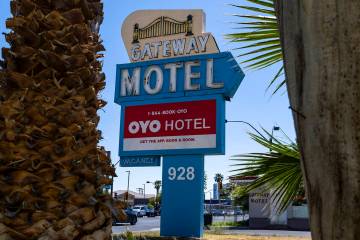Las Vegas police say young victims of sex trafficking could be ‘anyone’s child’
In a city that never sleeps such as Las Vegas, child sex trafficking has an environment in which to thrive.
Some argue that parents’ fear is unreasonable , emphasizing that it happens only to at-risk children, most of them from Third-World countries. Others maintain that legalizing prostitution would alleviate the problem, but those who work inside the trenches claim that children everywhere are targeted in this multi-billion dollar industry that preys on innocence and youth.
“The overall tolerance of prostitution from the community just has to stop,” said Metropolitan Police Department Lt. Patricia Spencer, who leads the Vice Section. “Believing that this is a victimless crime and it’s all consensual is all false. Most pimps will traffic a juvenile because they don’t have boundaries. A typical 16-year-old girl who runs away from her parents can be trafficked at any given time, and then getting her out of that life becomes a huge challenge for us. She could be anyone’s child.”
Who is targeted and how it works
Children — increasingly girls, police say — are being exploited at a high rate, and it’s not just those from broken homes, according to Heather Engle, director of the Women & Children’s Campus at WestCare Nevada, a nonprofit that includes services from substance abuse to homeless and runaway shelters, domestic violence, treatment and prevention, and mental health programs.
“Pimps look like normal, everyday people,” Engle said. “As a matter of fact, they look like you and me.”
That’s because women, too, are involved in the trade. They can start out acting like a mother or older sister-figure and friend.
They target teenage angst and social acceptance.
“It’s all based on the hierarchy of needs, and it happens a lot in middle-class America,” Engle said. “We assume it’s coming from broken homes, but it happens equally anywhere. No suburbia is safe.”
Professionals say the scenario is typically the same: The pimp starts a romantic relationship with the victim. He buys her clothes, takes her on trips and showers her with affection. Then, he claims he is in need of money and manipulates her to start selling herself. She does with a promise that it will be for only a short time, and then things turn violent. He threatens her if she leaves, and she stays out of fear.
It takes months to groom a victim, Engle said.
“They literally exploit and extort them,” Spencer added. “What juvenile wants their parents to know what they’re doing (in the sex trade)? They become trapped and can’t get out.”
Professionals tend to agree that between 70 percent and 80 percent of child sex trafficking victims who are caught are Las Vegas residents.
Tracie J. (last name withheld), 22, was introduced to the idea of sex trafficking through a senior at her high school.
“He was just talking to me and said, ‘You know, you’re looking good and filling out really nicely. I know your mom is a single mom. Wouldn’t you like to help her out more?’ I didn’t take him up on the offer, but the thought stayed in my head,” she said. “I was 15 at the time.”
A year later, Tracie J. was approached at a concert on Fremont Street by a guy who promised her wealth and excitement. She said he introduced her to adult prostitutes who flashed beautiful items, dressed glamorously and were “beautiful.”
“They treated me like family — it felt like a family,” she said.
From age 16 to 19, Tracie J. said she worked as a prostitute while living at home and balancing school. She said her mother found out and tried everything to stop her.
“There was physical abuse from my pimp, and there was an incident where a knife was pulled out on me from a trick,” Tracie J. said. “One day, I just finally had enough. At the end of the day, I knew I was better than my situation, and I deserved a better life.”
With help from The Embracing Project, a nonprofit that helps youths escaping the sex trafficking industry, and with support from her family and boyfriend, Tracie J. was able to quit, but she emphasized it took about a year for her to truly leave the business .
Esther Rodriguez Brown, founder of The Embracing Project and program administrator for sexually exploited youths in Family Court, said she’s seen a disproportionate number of minority victims. She estimated that 74 percent of the nonprofit’s clients are black.
“There really isn’t one primary indicator that says who can be targeted. These children can be from any social economic class and be of any race,” Spencer said. “Of course, those who are at higher risk to be targeted are youths who come from an abusive background or broken home, known as ‘throwaway kids.’ ”
The nation’s foster care system also leaves many young adults who have just turned 18 at the mercy of the streets. That was the case for Esmeralda (last name withheld), 23, a resident of Destiny House, a free, 12-month residential program founded to help women looking for the opportunity to escape from and re-establish their lives outside of the sex industry.
“I ran away from an abusive foster home when I was a teen with another young female, and we met some pimps at a mall,” she said. “They saw that it was near closing time and asked if we wanted to party. They taught us what to do and where to go. We were trafficked all over. We went to different cities and states.
“It’s a big problem with foster kids,” she added. “When I was in foster care, I met young girls that had already been trafficked. Foster kids are perfect because they’re looking for love, and pimps swoop in, acting like father figures. I was very much brainwashed.”
Sex in the city
Trade shows in Las Vegas bring in hundreds of thousands of people each year, looking for a little relief after a busy day of work, according to Engle.
“The slogan, ‘What happens here stays here’ comes down to the tolerance of the hotels and casinos to look at prostitution as a victimless crime,” Spencer said. “A lot of people think it should be legalized because it’s between consenting adults, but I can tell you 99 percent of women who are participating in prostitution are being trafficked. If they’re not being trafficked, it’s only a matter of time before they are. The problem with this is that it leads to having juveniles being brought into the industry. The overall tolerance of prostitution from the community facilitates the traffickers and enables them to victimize and exploit the youth of the community. Pimps don’t have morals or boundaries.”
Spencer said sex trafficking is a big problem in Las Vegas. As of April 19, 47 juveniles have been tracked, the youngest 12, she said.
From 1994 through 2015, over 2,654 minors (federally defined as younger than 18) have been recovered from human sex trafficking by Metro, according to Congo Justice Las Vegas, a human rights advocacy organization and a project of New Hope Foundation International.
Before claiming a juvenile as a victim, Metro confirms that they, in fact, have engaged in an act of prostitution and have a pimp, according to Spencer.
According to the nonprofit’s research from a shelter in Nevada, family members exploited 30 percent of domestically trafficked youths who were seeking services from the respective shelter.
“Pimps are everywhere. They have children, maybe teens, who go to school and use their own kids to recruit girls,” Rodriguez Brown said. “We’ve worked on a lot of cases where the girl is familiar with her pimp, where it’s the parents, father, aunt or uncle who exploit the child.”
Spencer estimated that fewer than 1 percent of the victims tracked are boys. Still, she warns it’s a problem.
“They are a very under-reported situation, but it still exists,” she said of males being child sex trafficked. “They’re not exploited quite the same way from what we’ve seen. Their situation is usually different from the traditional sense of trafficking. We usually see a boy selling himself, and he may have a partner helping to facilitate that.”
Members of the Latino community are also at risk due to language barriers and fear of asking for help because of their legal status, Rodriguez Brown said.
“Of all of the recovered juvenile victims, 70 percent have been recovered from casinos and hotels on Las Vegas Boulevard,” Spencer said. “The remaining 30 percent have been recovered from tracks, and 10 percent have been from elsewhere, such as schools or houses.”
Rodriguez Brown added that the juvenile court system sees an average of 200 youths charged with sex trafficking every year.
The evolution of technology
Technology has made it increasingly easier to buy and sell sex online.
No longer do pimps and human traffickers have to dangle their exploited victims in front of passers-by, hoping for a catch. Instead, they could conduct business online away from sight of the police.
Look no further than social media sites, such as Facebook, Twitter, Instagram and Snapchat for ways in which users can sell and buy sex online.
“Trafficking can be as high-level as Google or low-level as street,” Engle said.
Youths are sent to casinos or hotels to conduct business at night. On the Strip, advertisements for “hot babes at your door in 15 minutes” create an ambiguous but devious message to what may come, and it’s not always adults.
With so many hidden windows that point toward sex trafficking, how can parents keep their children safe? The answer is simple: Pay attention.
“This is a reality that parents need to be aware of,” Spencer said. “Kids do not deserve privacy, and parents need to get that through their head. Parents are the boss until their kids turn 18, and even then, they have the right to impose rules if they’re still living at home. They shouldn’t be allowed to have privacy because it’s dangerous. Once kids get wrapped up in this, they could wind up hurt or dead in another city.”
Spencer advises parents to look at who their children’s friends are on social media. She said it’s easy to spot pimps, who tend to flash their money and talk about “their hoes.”
“I always ask parents, ‘Would you put your child in the same bedroom as a 30-year-old male?’ When parents give access to the computer and social media, they are opening a door for an adult male to come in and have access to their child,” Rodriguez Brown said.
Leaving the industry behind
Professionals say one of the biggest challenges of leaving the sex industry behind is the lack of resources and safe homes.
Other challenges include the less-than-attractive offer of a stable and routine life, which includes going to school, doing homework and studying.
“Sometimes when these kids show up, we assume they want to get out, but that’s not always the case,” Engle said. “Some people have been involved in this industry so long that it’s all they know. When it comes to children, it’s a little different, but oftentimes, they’re just looking for love in all of the wrong places.”
Other hurdles come in the shape of the emotional bond formed with a pimp. Rodriguez Brown said it’s similar to being in an abusive relationship in which, typically, a victim goes back to the perpetrator multiple times before finally leaving.
“Getting out of prostitution takes a lot of support, hard work and commitment,” Tracie J. said. “Every time you engage in a sexual act with a stranger, they always take a piece of you with them. Once you lose yourself in this, it’s really hard to turn your life back around. Some people never get their life back.”
Fight starts with education, awareness
Rodriguez Brown said the average age entering the sex trade is 12, although she’s seen girls as young as 11 get involved, which is why she stresses that parents should talk to their children about what sex trafficking is and signs to watch out for.
She adds that parents should look for items that weren’t purchased by them, such as makeup, clothing, phones or jewelry. Bruises, physical markings and tattoos could also be an indicator.
“Parents need to remember that if their kids don’t hear it from them, they’ll learn about it from their peers, and that information might not always be right,” Rodriguez Brown said. “I once had a girl say that she thought she couldn’t get pregnant if she eats Takis (a spicy snack food). I asked her where she learned that from, and she answered, ‘From a friend.’ ”
She added that treating victims like delinquents and locking them up offers only a temporary solution and creates a mindset that they must keep running away from authorities.
Despite all that she has seen and heard, Rodriguez Brown remains hopeful about the world.
“I try not to count the failures but the successes,” Rodriguez Brown said. “Children are our future and the future of the world. More and more people are becoming aware about this problem and speaking up. As long as there’s awareness and people who fight against this, there is hope.”
Editor’s note: This is part two in series on sex trafficking in Las Vegas. Part three, focusing on the buyers (aka Johns), is set to run June 2.
To reach North View reporter Sandy Lopez, email slopez@viewnews.com or call 702-383-4686. Find her on Twitter: @JournalismSandy
Report trafficking
To report in-progress activities involving prostitution and potential victims of human trafficking, call Metro's non-emergency line at 702-828-3111.
For crimes not in progress, call Crime Stoppers at 702-385-5555, leave a message at 702-828-8423, or email Vice@LVMPD.com.
Callers can also refer information to the National Human Trafficking Resource Center Hotline at 888-373-7888.
For more information on human trafficking, visit ag.nv.gov or lvmpd.com.






















